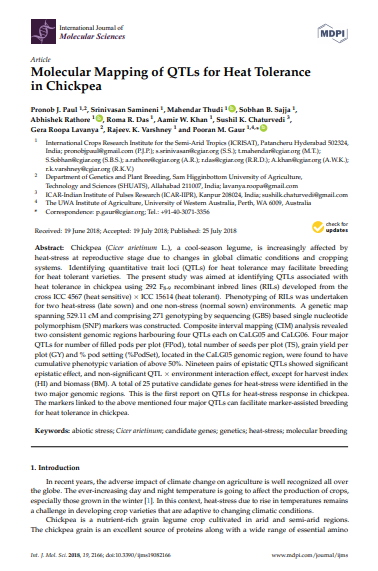Molecular mapping of QTLs for heat tolerance in chickpea
Summary
Chickpea (Cicer arietinum L.), a cool-season legume, is increasingly affected by heat stress at the reproductive stage due to changes in global climatic conditions and cropping systems. Identifying quantitative trait loci (QTLs) for heat tolerance may facilitate breeding for heat-tolerant varieties. The present study aimed to identify QTLs associated with heat tolerance in chickpea using 292 F8-9 recombinant inbred lines (RILs) developed from the cross ICC 4567 (heat sensitive) × ICC 15614 (heat tolerant). Phenotyping of RILs was undertaken for two heat-stress (late sown) and one non-stress (normal sown) environments. A genetic map spanning 529.11 cM and comprising 271 genotyping by sequencing (GBS) based single nucleotide polymorphism (SNP) markers was constructed. Composite interval mapping (CIM) analysis revealed two consistent genomic regions harbouring four QTLs each on CaLG05 and CaLG06. Four major QTLs for number of filled pods per plot (FPod), total number of seeds per plot (TS), grain yield per plot (GY), and % pod setting (%PodSet), located in the CaLG05 genomic region, were found to have a cumulative phenotypic variation of above 50%. Nineteen pairs of epistatic QTLs showed a significant epistatic effect, and a non-significant QTL × environment interaction effect, except for harvest index (HI) and biomass (BM). A total of 25 putative candidate genes for heat stress were identified in the two major genomic regions. This is the first report on QTLs for heat-stress response in chickpea. The markers linked to the abovementioned four major QTLs can facilitate marker-assisted breeding for heat tolerance in chickpea.
Open resource Download resource Access resource on external site

